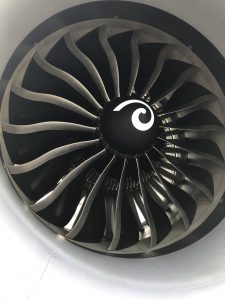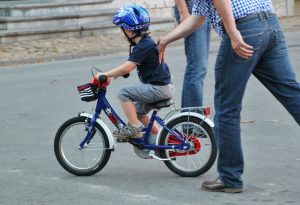
The function of the cerebellum is similar to the function of a thermostat. We use a thermostat to control the temperature in our house. The thermostat controls the central heating boiler, but does not heat the house itself. This also holds for the cerebellum: the cerebellum controls the motor cortex, which in turn controls the muscles (the counterpart of the central heating boiler). A thermostat only knows how to control the central heating boiler if he gets information about about the current temperature, and for that he makes use of a thermometer. This also holds for the cerebellum: the cerebellum only knows how to control the motor cortex thanks to information from the sensory organs. For staying upright on a bicycle, especially the vestibular organ and proprioception are important. If the sensory organs indicate that some desired position (e.g., being in balance) is not yet achieved, then the cerebellum sends a signal to the motor cortex.
Although this thermostat metaphor is broadly correct, it is not correct for the full 100 percent. A couple differences between the workings of a thermostat and the cerebellum are essential for a good understanding, but a few others are not. We start with the latter:
- The cerebellum does not only send a signal to the motor cortex, but also to the premotor and the prefrontal cortex. We will introduce the signals from the cerebellum to the premotor and the prefrontal cortex when discussing the role of anticipation.
- The cerebellum does not send its signals directly to the motor cortex, but via an intermediate station, the thalamus.
A number of other differences are essential, and these are now discussed more extensively:
- The motor cortex controls complex movements
- The cerebellum receives information from multiple sensory organs
- The cerebellum receives information from the motor cortex
- The cerebellum makes a prediction of the sensory consequences of a motor signal
- The cerebellum learns from its prediction errors
1. The motor cortex controls complex movements

Most central heating boilers can be in only one of two possible states: on or off. The movements of our limbs, on the other hand, cannot be described in terms of only two possible states (moving versus still, left versus right, etc.). Instead, these movements are characterised by at least two quantitative parameters: movement direction and speed. This implies that our motor cortex can produce a much more complex output than a central heating boiler.
A better metaphor for the joint operation of the motor cortex and the cerebellum is that of a space in which one wants to control the direction and the speed of the wind (e.g., a recording studio for films). This is possible by means of fans that are located at the side of the space. By choosing a combination of fans and adjusting their speed one can produce a wind with an arbitrary direction and speed. The chosen combination of fans and speeds corresponds to muscle groups and their associated forces that together produce a limb movement in a particular direction and with a particular speed.
2. The cerebellum receives information from multiple sensory organs

Whether a central heating boiler is turned on or not only depends on a measurement with a single instrument: the thermometer. This does not hold for the cerebellum, which receives information from multiple senses: vestibular organ, touch receptors (in our skin, joints and muscles), eyes and ears. Using the wind generator metaphor, we can compare these senses to toy windmills with which one can measure the current direction and speed of the wind. Each of these windmills sends a signal to the unit that controls the fans. These signals are proportional to their rotation speed, and the control unit interprets these signals in terms of their position and orientation in the space in which one wants to control the wind. On the basis of this information from the toy windmills, the control unit can make an estimate of the current direction and speed of the wind.
Obtaining information from multiple sensory organs (instead of a single one) has an important advantage: if one of these sensory organs malfunctions, or the quality of its signal deteriorates, then another sensory organ can take over. This is in line with our wind generator metaphor but not with our thermostat metaphor: if the thermometer of a thermostat is broken, that thermostat can no longer perform its task, but if some of the toy windmills are broken, the remaining ones may still provide enough information for the control unit to make an accurate estimate of the current direction and speed of the wind. This also holds for the cerebellum: if the signal of some sensory organ deteriorates, then the cerebellum is capable of replacing the information provided by that sensory organ by the information that is provided by another. This is the case, for instance, with the vestibular organ, of which the signal quality diminishes with age. The touch receptors and the eyes can in principle take over the role of the vestibular organ. Especially our sense of touch is very useful for staying upright on a bicycle: if the bicycle is in balance, one can release the handlebars, and this sensation (releasing the handlebars while the bicycle is going straight) is a signal for the cerebellum that there is no need for steering or weight displacement. The possibility that our sense of touch (partially) replaces the function of our vestibular organ is basis of a number of exercises in staying upright.
3. The cerebellum receives information from the motor cortex
![By Michelle Costanzo (Theories of Motor Control, UMD Spring 2008) [GFDL (http://www.gnu.org/copyleft/fdl.html) or CC-BY-SA-3.0 (http://creativecommons.org/licenses/by-sa/3.0/)], via Wikimedia Commons](https://ikblijffietsen.nl/wp-content/uploads/2018/05/Corollary_Discharge_vs_Efference_Copy.png)
4. The cerebellum makes a prediction of the sensory consequences of a motor signal
The cerebellum uses the efference copy for predicting the effect of the motor signal that is sent to the muscles. When you make a movement, this changes the position of you limbs and this you feel. In other words, you receive receive sensory feedback about your own movements. This sensory feedback is used to adjust the movements. In fact, the motor signal not always produces exactly the planned movement, and the cerebellum can detect this via the difference between (1) the perceived sensory feedback, and (2) the predicted sensory feedback that the cerebellum has generated on the basis of the efferent copy. In the figure above, this difference is denoted as “Sensory Discrepancy”.
This mechanism can be described more concretely in terms of the wind generator metaphor. When the control unit of the wind generator sends a signal to the fans, then a copy of this signal is used to make a prediction of the rotation speed of each of the windmills. Because of inaccuracies in the control, the fans do not produce exactly the desired direction and speed of the wind, and this is observed by comparing the predicted rotation speeds of the windmills with the ones that were actually observed. On the basis of this difference the control of the fans can be adjusted such that the desired direction and speed of the wind is better approximated.
In the same way, our cerebellum makes use of the sensory feedback about our balance (obtained from our vestibular organ), the position of our joints, and the tension of our muscles (obtained from our proprioception). If this sensory feedback differs from the predicted sensory feedback (produced by the cerebellum on the basis of the efference copy), then the control of the muscles can be adjusted such that the desired position is better approximated.
5. The cerebellum learns from its prediction errors

A thermostat is set up by its user. The cerebellum, however, sets itself up, and does this on the basis of the sensory discrepancy (the difference between the observed and the predicted sensory feedback). To understand this, one should know that the motor cortex can in principle produce all movements by itself, without the help of the cerebellum. However, the control by the motor cortex is jerky and poorly coordinated. This type of uncoordinated movements can be observed with a beginning cyclist. Gradually, the cerebellum learns the pattern of movements that is required to keep the bicycle in balance and to steer it. To realise this, the cerebellum sends corrective signals to the motor cortex, and this results in movements that are better coordinated.
The precise corrective control of the motor cortex has to be learned, and the cerebellum does this on the basis of the sensory discrepancy: when this discrepancy is large, a signal is sent to the cerebellum that alters the existing neuronal connections. These altered neuronal connections result in an improved control of the motor cortex. This mechanism can be clarified using the wind generator metaphor. To control the fans, this system must learn two things:
- Making a correct prediction of the effect of a particular control signal on the rotation speeds of the toy windmills (the system’s sensory organs).
- Correctly controlling the fans (the system’s muscles).
The system can in principle learn this on the basis of the discrepancy of the observed and the predicted rotation speeds of the windmills. In the same way, the cerebellum learns to improve its control of the muscles:
- Making a prediction of the sensory feedback that results from a particular control signal sent by the motor cortes to the muscles.
- Adjusting the motor cortex such that the sensory discrepancy is reduced. We make use of this feature when we make a steering error.
As a result of focused experience, the cerebellum becomes an increasingly better supporter of the motor cortex. We express this by saying that the cycling skill is automatised. For this reason, the cerebellum is not only the master controller but also the master automator.
The precise details of the workings of the cerebellum are the subject of much ongoing studies. The mechanism that was described in the above is a simplified version of the mechanism that is the most likely one on the basis of our current knowledge. One can find a good overview of our current knowledge of the cerebellum in this video.